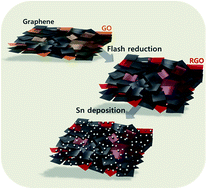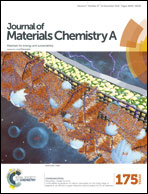Flash-induced reduced graphene oxide as a Sn anode host for high performance sodium ion batteries†
Abstract
Sn is a promising anode material for sodium ion batteries due to its high capacity. However, the fast capacity fading caused by large volume changes limits the employment of Sn anodes. Graphene has been considered as a host for Sn anode materials to improve the cycle performance. However, graphene scaffold preparation with large free spaces is challenging due to the need for a sacrificial template and etching process. Here, we prepared a porous scaffold composed of both reduced graphene oxide and graphene via a camera flash reduction as the host for Sn. The camera flash induces the reduction of the graphene oxide and pores generated by the c-axis popping of the graphene. The mechanical strength of the scaffold is also achieved by adjusting the concentration of graphene which does not react with the flash light. The porosity and mechanical properties of the reduced graphene oxide–graphene scaffold could be controlled by flash irradiation conditions and the mixing ratio between the graphene oxide and graphene. The porous scaffold enables a uniform Sn loading and an improvement in the sodium ion battery performance due to a sufficient free space for accommodating the Sn volume change and mechanical stability.


 Please wait while we load your content...
Please wait while we load your content...